Let me tell you, if you’re hunting for a skincare gem that hydrates without the grease and soothes like a dream, Innisfree Green Tea Seed Serum is your answer.
I was skeptical at first, but this lightweight, eco-friendly serum from Korea’s Jeju Island transformed my skin in days. It’s a game-changer for anyone craving that dewy, glowing look without breaking the bank. Trust me, you’ll want this in your routine—your skin will thank you!
My Journey With Innisfree Green Tea Seed Serum
Picture this: it’s a brutal winter in New York, and my skin is screaming for help. Normally, I’ve got combination skin—oily in the T-zone, dry on the cheeks—but the cold turned it into a flaky, tight mess. My usual face wash and moisturizer combo wasn’t cutting it.
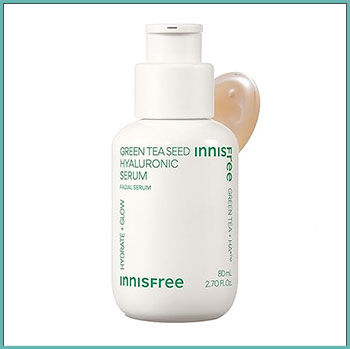
I’d heard buzz about Korean skincare, so when I stumbled across Innisfree Green Tea Seed Serum, I figured, why not? The eco-conscious packaging and promise of Jeju Island green tea hooked me.
The first time I pumped out the serum, I was struck by its texture—light, almost watery, with a faint, refreshing green tea scent that felt like a spa moment.
I applied it right after cleansing, patting it into my damp face as recommended. It sank in instantly, no sticky residue, just a soft, velvety finish. Within days, I noticed my skin felt plumper, less irritated, and that annoying tightness was gone.
By the end of the week, my cheeks were glowing, and even my coworkers asked what I was using. No joke—someone thought I’d gotten Botox!
What blew me away was how little I needed. One pump covered my face and neck, and the 80ml bottle lasted months. I started using it morning and night, and it became the cornerstone of my routine. It’s not just hydration—it’s like giving your skin a tall glass of water while calming any redness.
For someone who’d never been consistent with skincare, this serum was a revelation. It inspired me to rethink my entire routine, and now I’m that person who nerds out over ingredients lists.
The Pros Of Innisfree Green Tea Seed Serum
- Lightweight Hydration That Delivers: This serum is a hydration powerhouse without the heaviness. Its 75.9% green tea extract, sourced from Innisfree’s USDA-organic fields on Jeju Island, floods your skin with moisture. I’ve got combination skin, and it strikes the perfect balance—my oily zones don’t feel slick, and my dry patches stay quenched. Users with sensitive skin or rosacea often rave about its soothing properties, and I can see why. It’s like a cool drink for parched skin, leaving it soft and dewy.
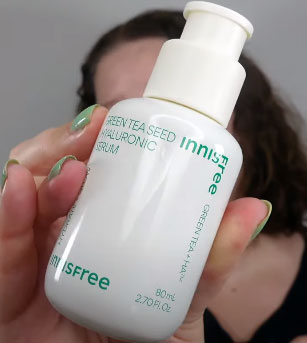
- Gentle for Sensitive Skin: If your skin throws a tantrum at every new product, you’ll love this. The serum is formulated without parabens, mineral oil, or synthetic colors, making it a safe bet for sensitive types. I’ve read reviews from folks with rosacea who swear by it, and while I don’t have that condition, I never once felt irritation. The green tea’s anti-inflammatory properties calm redness, and the absence of alcohol in newer formulations ensures it won’t dry you out.
- Eco-Friendly and Long-Lasting: Innisfree’s commitment to sustainability is a big win. The bottle is recyclable, and they partner with TerraCycle for a no-waste program. Plus, the pump design is genius—no accidental spills, and it’s travel-friendly. You only need a small amount, so one bottle stretches for months, even with twice-daily use. For a product that performs this well, it’s surprisingly affordable, making it a staple you won’t dread repurchasing.
- Boosts Your Routine’s Effectiveness: This serum isn’t just a solo act—it preps your skin for whatever comes next. Applied on a damp face, it opens up your skin’s moisture pathways, so your toner or moisturizer works harder. I noticed my moisturizer absorbed better when I used the serum first, giving me that coveted glass-skin glow. It’s like a primer for your skincare, amplifying everything else you slather on.
Also Read: My Thoughts On Cocokind Ceramide Barrier Serum
The Cons You Should Know About
- Fragrance Might Not Suit Everyone: While I love the fresh, citrusy green tea scent, it could be a dealbreaker if you’re sensitive to fragrances. Some users with ultra-sensitive skin report mild irritation, likely due to the natural citrus extracts like grapefruit and tangerine. If you prefer fragrance-free products, you might want to patch-test this first. That said, the scent fades quickly, so it’s not a lingering issue for most.
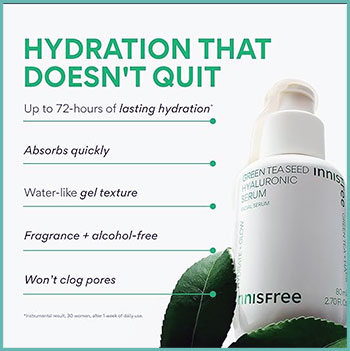
- Not a Miracle Worker for Advanced Concerns: Let’s be real—this serum is a hydrating champ, but it’s not going to erase deep wrinkles or severe acne scars. If you’re looking for heavy-hitting anti-aging or acne treatment, you’ll need to pair it with targeted actives like retinol or salicylic acid. For me, it kept my skin balanced and glowy, but I didn’t see dramatic changes in texture or pigmentation. It’s best for hydration and maintenance, not a full-on skin overhaul.
- Ingredient List Could Be Clearer: One gripe I have is the packaging. The bottle itself doesn’t list ingredients in English, which can be frustrating if you’re ingredient-savvy like me. You’ll need to check the box or Innisfree’s website to confirm what’s inside. While the star ingredient—75.9% green tea extract—is legit, the lack of transparency on the bottle feels like a miss for a brand that’s otherwise so user-friendly.
How Does It Stack Up Against Other Brands?
- SKIN1004 Centella Ampoule: I’ve tried SKIN1004’s Centella Ampoule, a favorite for sensitive skin, and it’s a solid contender. It’s 100% centella asiatica extract, which soothes like nobody’s business—perfect if you’ve got redness or irritation. It’s more watery than Innisfree’s serum and fragrance-free, which might appeal to those who find Innisfree’s scent too strong. However, it lacks the same dewy finish and doesn’t hydrate as deeply for my combination skin. If calming is your priority, SKIN1004 might edge out, but for all-around hydration, Innisfree takes the crown.
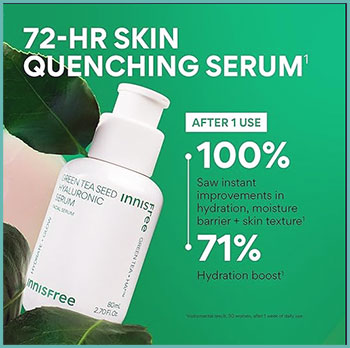
- Peach & Lily Glass Skin Refining Serum: Peach & Lily’s Glass Skin Refining Serum is another K-beauty star I’ve tested. It’s packed with niacinamide, peptides, and hyaluronic acid, aiming for that radiant, poreless look. It’s fantastic for brightening and feels lightweight, but it’s pricier than Innisfree and slightly tackier on application. I found it less soothing for my occasional redness, and the hydration didn’t last as long. If you want a multitasking serum with brightening benefits, Peach & Lily is great, but Innisfree’s simplicity and affordability make it more versatile for daily use.
- Geek & Gorgeous C-Glow Serum: For a Vitamin C option, I’ve used Geek & Gorgeous C-Glow, which is a budget-friendly antioxidant serum. It’s got 15% Vitamin C, perfect for brightening and fighting free radicals, but it’s not as hydrating as Innisfree. The texture is runnier, and it can sting if your skin’s compromised. I prefer Innisfree for morning routines when I need hydration and a glow without irritation. Geek & Gorgeous is better for targeted anti-aging, but it’s less beginner-friendly than Innisfree’s gentle formula.
- Glow Recipe Plum Plump Hyaluronic Serum: Glow Recipe’s Plum Plump Hyaluronic Serum is a hydration heavyweight with fermented ingredients and panthenol. It’s thicker and tackier than Innisfree, with a stronger fruity scent that lingers. I enjoyed its plumping effect, but it felt heavier on my oily zones and was pricier. Innisfree’s serum absorbs faster and suits humid climates better, while Glow Recipe might be ideal for drier skin types needing extra moisture. If you travel often, Innisfree’s fuss-free bottle wins for portability.
Tips to Get the Most Out of Your Serum
- Apply on Damp Skin for Maximum Absorption: Here’s a game-changer: always apply this serum on a damp face. After cleansing, don’t fully dry your skin—pat it lightly and pump out a small amount of serum. The water on your face helps the green tea extract penetrate deeper, locking in moisture. I learned this the hard way; applying it on dry skin felt less effective, and my face didn’t glow as much. Trust me, this simple step makes a huge difference.
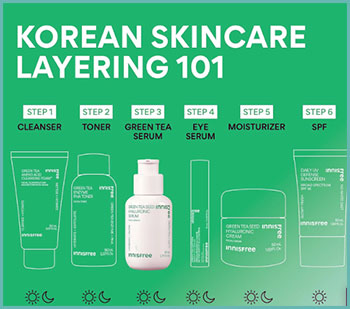
- Layer It Strategically: To supercharge your routine, use the serum as your first step after cleansing. Follow with a toner, then a moisturizer to seal it in. I pair it with Innisfree’s Green Tea Toner for extra hydration, and it’s like a one-two punch for dewy skin. If you’re using actives like retinol or Vitamin C, apply them after the serum to avoid irritation. Just wait a minute for the serum to sink in before piling on other products.
- Store It Properly: Keep your serum in a cool, dry place away from direct sunlight. I store mine in my bathroom cabinet, and it’s stayed fresh for months. If you’re traveling, the pump’s protective cap prevents leaks, but don’t toss it in a hot car—it could degrade the green tea’s potency. If you live in a super humid climate, consider popping it in the fridge for an extra refreshing application.
- Patch Test if You’re Sensitive: If you’ve got sensitive skin, do a patch test before going all-in. Apply a small amount behind your ear or on your inner arm for 24 hours to check for reactions. I didn’t need to do this, but I’ve read about rare cases where the citrus extracts caused mild irritation. Better safe than sorry, especially if you’re new to K-beauty.
- Use Consistently for Best Results: Consistency is key with this serum. I saw results in a week, but the real magic happens with daily use. Morning and night is ideal, but even once a day can keep your skin hydrated. If you’re in a dry climate, like I was in winter, don’t skip it—your skin will drink it up. Stick with it, and you’ll notice smoother, more radiant skin over time.
Read More: My Thoughts On Acure Brightening Vitamin C & Ferulic Acid Serum
Frequently Asked Questions (FAQ)
This serum is a hydration hero, perfect for quenching dry or dehydrated skin while soothing redness and irritation. Its green tea extract, rich in antioxidants, protects against environmental stress and promotes a dewy glow. It’s great for maintaining skin balance and prepping your face for other products, though it’s not designed for intensive anti-aging or acne treatment.
You can use it twice daily—morning and night—after cleansing. Apply it to damp skin for best results. If you’re super busy, once a day works, but consistent use amps up the hydration and glow. A little goes a long way, so one pump is enough per application.
No, this serum doesn’t contain retinol. It’s focused on hydration and soothing, with green tea extract and seed oil as the stars. If you want retinol, Innisfree’s Retinol Cica Repair Ampoule is a separate product you could pair with this for a more targeted routine.
It’s versatile for all skin types but shines for combination, oily, or dehydrated skin. Sensitive skin types often love its gentle formula, though fragrance-sensitive folks should patch-test. If you’ve got very dry skin, you might need a heavier moisturizer on top, but it still hydrates beautifully.
Final Thoughts
I’m hooked on Innisfree Green Tea Seed Serum, and you will be too. It’s affordable, eco-friendly, and delivers hydration that makes your skin glow like you just left a spa. Whether you’re battling dryness or just want a dewy boost, this serum fits seamlessly into your routine. Grab a bottle, and watch your skin transform—you won’t look back!
